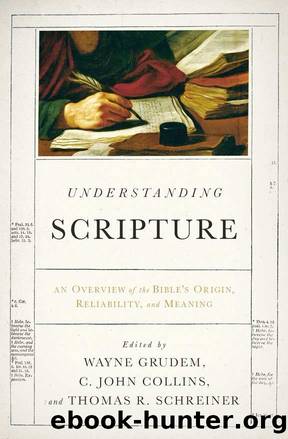Understanding Scripture: An Overview of the Bible's Origin, Reliability, and Meaning by unknow

Author:unknow
Language: eng
Format: mobi
Tags: Religion, Reliability, Bible's Origin, Biblical Studies
ISBN: 9781433529993
Publisher: Crossway
Published: 2012-02-27T22:00:00+00:00
OLD TESTAMENT TEXTUAL CRITICISM
Scholars agree that no single witness perfectly reproduces the original Hebrew text (generally called âUrtextâ) of the entire Old Testament, and therefore textual criticism is necessary. Textual criticism is the science and art that seeks to determine the most reliable original wording of a text. It is a science because specific rules govern the evaluation of various types of copyist errors and readings, but it is also an art because these rules cannot be rigidly applied in every situation. The goal of Old Testament textual criticism is to work back as closely as possible to the final form of the text as it was canonized and maintained by the scribes. Since the texts were transmitted over such a long period, one could expect that minor errors might have crept in. Comparison of various forms of the Old Testament text helps determine the most plausible reading of the original texts. Intuition and common sense must guide this process. Informed judgments about a text depend upon oneâs familiarity with copyist errors, manuscripts, versions, and their authors.
Types of Errors
Even given a strong desire to maintain an authoritative, standardized text, common copyist errors can creep in, including: confusion of similar letters, homophony (substitution of similar sounding letters or words), haplography (omission of a letter or word), dittography (doubling a letter or word), metathesis (reversal in the order of two letters or words), fusion (two words being joined as one), and fission (one word separated into two).
The Process
Modern critical editions of the MT include the BHS (Biblia Hebraica Stuttgartensia) and the BHQ (Biblia Hebraica Quinta), which follow the Codex Leningradensis (AD 1008), and the Hebrew University Bible Project, which follows the Aleppo Codex (c. 930). They derive from the longest and, to date, most reliable textual tradition overall. This tradition was maintained by the Masoretes, and when compared to the Qumran manuscripts dated about one thousand years earlier, was found to be very accurate. These critical editions also provide a summary of pertinent information from other sources in their textual apparatus. The process of Old Testament textual criticism includes examining the external evidence from various Hebrew sources (e.g., Dead Sea Scrolls, Samaritan Pentateuch, medieval manuscripts) and versions (e.g., Septuagint, Latin Vulgate, etc.) to determine which is the most plausible original reading of the text.
When weighing evidence, scholars generally agree that the Hebrew sources take precedence over the versions, though versions sometimes contain what appears as a plausible original reading. Internal evidence is then examined to see if there are any hints to help determine the original reading (e.g., grammatical structures, common spelling). At times, discoveries from other ancient Semitic languages have shed light on previously unintelligible texts. Guidelines to use in determining the most plausible original readings include: (1) Which reading could most likely give rise to the others? (2) Which reading is most appropriate in its context? (3) The weight of the manuscript evidence is then evaluated to determine whether it may contain a secondary reading or gloss. Only a very
Download
This site does not store any files on its server. We only index and link to content provided by other sites. Please contact the content providers to delete copyright contents if any and email us, we'll remove relevant links or contents immediately.
The Five People You Meet in Heaven by Mitch Albom(3453)
Real Sex by Lauren F. Winner(2948)
Name Book, The: Over 10,000 Names--Their Meanings, Origins, and Spiritual Significance by Astoria Dorothy(2923)
The Secret Power of Speaking God's Word by Joyce Meyer(2906)
The Holy Spirit by Billy Graham(2868)
0041152001443424520 .pdf by Unknown(2757)
ESV Study Bible by Crossway(2722)
How The Mind Works by Steven Pinker(2710)
Ancient Worlds by Michael Scott(2605)
Churchill by Paul Johnson(2492)
The ESV Study Bible by Crossway Bibles(2485)
The Meaning of the Library by unknow(2484)
The Gnostic Gospels by Pagels Elaine(2454)
MOSES THE EGYPTIAN by Jan Assmann(2358)
Jesus by Paul Johnson(2290)
City of Stairs by Robert Jackson Bennett(2283)
The Complete Dead Sea Scrolls in English (7th Edition) (Penguin Classics) by Geza Vermes(2218)
Ancient Near Eastern Thought and the Old Testament by John H. Walton(2181)
The Nativity by Geza Vermes(2161)
